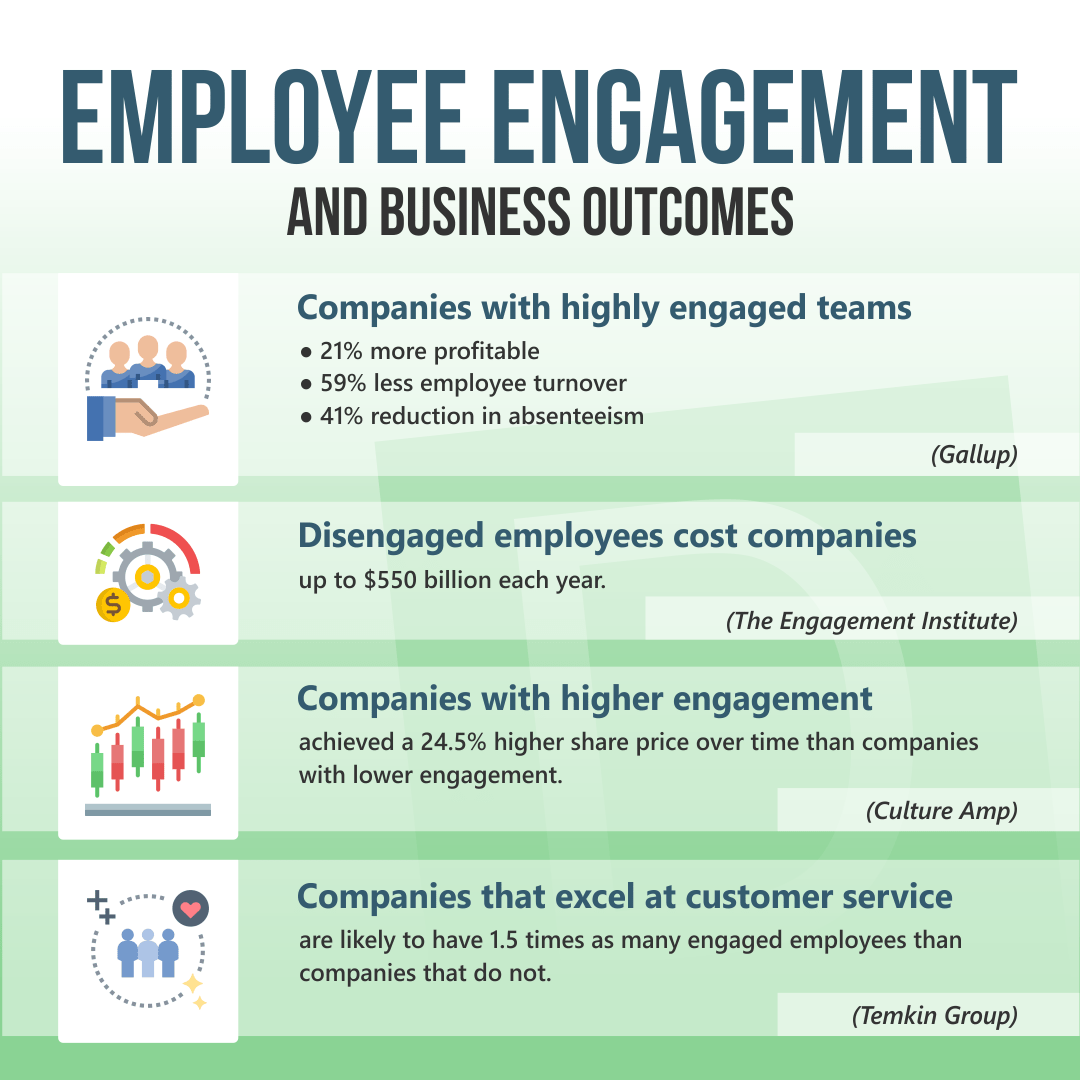
Employee engagement has clear links to business outcomes. When you have high levels of engagement, your business is likely to be more successful. If you aren’t measuring the return on investment (ROI) on employee engagement, your efforts to improve engagement may be futile. By using employee engagement measurement tools, systems and strategies you can calculate your employee engagement ROI.
Table of contents
How employee engagement is linked to business outcomes
How to measure employee engagement
What is ROI, and how do you approach measuring it?
Calculating your overall ROI on employee engagement
How to determine the success of your employee engagement strategy
Cost-effective ways to maximize your ROI on employee engagement
How much should you invest in employee engagement?
What is employee engagement?
Employee engagement is a term used to describe employees’ connection with their organization, motivation, enthusiasm, job satisfaction, and commitment to remaining with the organization. Employees who are engaged at work are more likely to be productive and are enthused to contribute to the company’s success. They have a positive impact on productivity and morale.
Employees who are disengaged have the opposite effect: they are likely to be unproductive, cut corners, make mistakes, bring down morale and drain profits. In addition, they are likely to have higher levels of absenteeism, presenteeism, affect customer service and ultimately leave the company, causing you replacement costs.
How employee engagement is linked to business outcomes
Many different studies have found clear links between levels of employee engagement and the success of a business – including productivity, profitability and employee turnover rates. Things like workers’ compensation claims, law suits and mistakes with products and projects can also be linked to engagement.
Research from Gallup has revealed that companies with highly engaged teams are 21% more profitable, have 59% less employee turnover, and a 41% reduction in absenteeism.
A report by The Engagement Institute found that in the United States alone, disengaged employees cost companies an estimated $450 billion to $550 billion each year.
But it isn’t only inside the company that this can be seen. There are external factors that employee engagement can influence as well.
A Culture Amp study examined companies who had conducted full census engagement studies and compared their stock market share price growth over a 12-month period. The study found that companies with higher engagement achieved a 24.5% higher share price over time than companies with lower engagement.
There’s a business adage that it costs companies more money to find new customers than it does to keep existing ones happy. This is because when they are happy, they’re more likely to keep coming back and repeat customers are good for profits.
Employee engagement plays an important role in customer satisfaction.
A study by the Temkin Group found that companies that excel at customer service are likely to have 1.5 times as many engaged employees than companies that do not.

How to measure employee engagement
There are several different ways to measure levels of employee engagement, using both quantitative and qualitative methods.
These includes:
1. Benchmarking surveys
A benchmarking survey is a comprehensive set of questions on various engagement indicators that are sent to the entire organization. The survey should be completed at regular intervals so you can compare like for like and determine if there has been any change, positive or negative.
2. Pulse surveys
These are smaller surveys than the benchmarking survey but can be sent at any time, usually to get an overall feel for how people are going (taking the ‘pulse’ of the organization, as it were).
3. One-on-one conversations
This method relies on representatives from the HR department holding confidential conversations with employees on a range of topics related to engagement to get an idea of how people are feeling, their concerns, and what may be causing any issues.
4. Analyzing existing data
Your company will already have different types of data that you can examine to offer insight into engagement levels. This can include absences, profits, employee turnover and other metrics (these will be discussed later in the article).
5. Exit interviews
While there are many reasons why people leave companies, a common one is because they dislike their job and/or their manager and/or the company. You won’t know for sure unless you ask people why they are leaving. Generally, people feel more comfortable giving truthful answers in an exit interview than they might do when they aren’t leaving (fear of recriminations and reprisals, for example).
6. Employee net promoter score
The employee net promoter score (eNPS) is borrowed from an external marketing measurement strategy for measuring customer loyalty. It is based on asking your employees a simple question: how likely on a scale of 1 to 10 are you to recommend the company to family and friends? It is very easy to implement and lets you benchmark your employee engagement over time.
- COVID-19 Employee Survey (33 questions)
- Workplace Stress Assessment Questionnaire. (19 questions)
- Top 25 Internal Communications Questions
- Your Anonymous Survey (41 questions)
- Employee Satisfaction Survey (30 questions)

What is ROI, and how do you approach measuring it?
ROI stands for ‘return on investment,’ and in the context of employee engagement, it is used to determine whether or not any time and resources that are put towards employee engagement activities have been of financial benefit to the company’s bottom line.
There are two main approaches to determining ROI on employee engagement. These are:
1. Determining how much money the company loses because of disengaged employees
2. Determining how much money can be gained by engaging or re-engaging employees.
Each approach examines productivity, employee turnover rates, employee theft and employee morale, which can negatively impact profitability.
Methods to calculate your ROI on employee engagement
There are a number of ways you can calculate the ROI on your employee engagement activities and initiatives.
A lot of data is already held by your company that you can use for tracking employee engagement, such as output, productivity, length of tenure, turnover rates and other finances linked to employees. Some of these employee engagement measurement methods include:
1. Employee net promoter score (eNPS)
As mentioned earlier in this article, the employee net promoter score involves asking employees to rate on a scale of 1 to 10 how likely they are to recommend the company to family and friends.
If an employee scores 9-10 they are considered a ‘promoter’. If they score 7-8 they are considered passive. And if they answer 0-6 they are considered to be ‘detractors’.
You can calculate your eNPS by subtracting the percentage of promoters from the detractors to determine your score.
In future eNPS surveys you can see if this number goes up or down. If it goes up, that means your engagement is faring better.
2. Employee productivity
There is no one-size-fits-all way to measure employee productivity. How productivity looks in one company or industry may look very different in another.
Generally, however, there are a range of indicators you can look for to determine if productivity has taken a hit in your business. If you have more than one of these, it could be a red flag that there are employee engagement issues:
- Deadlines not met
- KPIs not met
- Daily or monthly quotas not met
- Mistakes being made
- Lack of attention to detail
- Returned products for being faulty
- Unhappy customers
- Legal issues.
These issues in and of themselves aren’t always necessarily the result of low engagement. For example, deadlines can be missed because of equipment failure, outages or adverse weather events. The issue might also be a one-off. What you need to do is to look for patterns emerging in your data to see if there is a likely overall engagement issue.
3. Revenue per employee
This method of employee engagement tracking is a financial benchmark that helps to determine the average financial productivity of every employee in an organization. You can then use it to benchmark against data from other companies within your industry. It’s important to benchmark against your industry only as there are different labor intensity requirements in different industries and occupation groups.
It’s fairly simple to calculate revenue per employee: what you need to do is take the total revenue of your company and divide it by the total number of full-time equivalent employees that you have.
4. Cost of employee turnover
There are a number of reasons why employees leave a company, and not all of them have to do with employee engagement. They might be retiring, they might want to spend more time with family, they may be relocating, they might be going back to school, or they may wish to pursue a different line of work. They may leave because the current organization doesn’t have a clear career progression path or because they can make more money elsewhere. Other times they leave because they don’t like their job, their manager and/or the company and its culture.
But usually, high levels of employee turnover indicate a cultural problem that is linked to engagement.
To determine your employee turnover rate, you need to know how many employees you had at the beginning of the month, how many at the end of the month, and the number who left during the month.
Next, you should calculate the average by adding the beginning and end of month workforce numbers and divide by two. Divide the number of employees who left the organization by the average employee number and then time this by 100 to get a final turnover percentage.
By analyzing this data month on month, you can see trends develop. You can also look at how many employees left the company over the course of the year. It’s generally accepted that it costs around 33% of an employee’s salary to replace them. This factors in things like recruitment, onboarding and training. If you’re losing a large number of employees each year, this figure is going to be large.
5. Cost of absenteeism
Absenteeism is when employees fail to show up to work more than what is expected. People are human and it is reasonable to anticipate that they will become ill or have to deal with family emergencies and other issues that can cause them to miss work. But other absences are because people just don’t want to come in anymore. They might hate their particular job, there could be a lot of stress involved, bullying and harassment and other issues that cause low morale and engagement.
According to research from a workplace consultancy firm, unscheduled absenteeism costs around $3600 per year for hourly workers and $2660 a year for salaried workers.
These costs are associated with factors such as having to pay wages to absent employees, paying other employees overtime to make up for the missing employee, paying for temporary workers and administrative costs arising from the management of the absenteeism.
To calculate your absenteeism rate, you need to determine the average number of employees times the number of missing workdays (A). You then need to calculate the average number of employees times total workdays (B). Divide figure A by figure B and you’ll have your absenteeism figure.
Calculating your overall ROI on employee engagement

The methods above can be used as standalone ways to determine your ROI on employee engagement. There’s also a more advanced way that incorporates some of the above. Use the following steps:
- Calculate the revenue per employee (divide the company’s annual revenue by the average number of employees) (A)
- Determine the cost of absenteeism per employee. To do this work out the total number of working days lost to absenteeism. For example, you might find that it is 1.7% of total working days. You then need to multiply this percentage by the average employee salary Multiply the absenteeism percentage by the revenue per employee from the previous step. (B).
- Determine the cost of employee turnover. It costs around 6 to 9 months of an employee’s salary to replace them. Multiply the number of employees who quit by the average cost of 6-9 months salary. (D)
- Your total ROI can then be calculated by measuring any increase in revenue per employee (A), money saved from a reduction in absenteeism (B) and any decrease in employee turnover (C).
- Then, you can sum up these numbers and compare them to the total sum of money spent for employee engagement in the same period. That is how you can determine if your investments paid off.
How to determine the success of your employee engagement strategy
If your company has put a lot of time and effort (and funds!) into improving employee engagement, you may not be seeing the results you had hoped. Measuring the ROI of your employee engagement programs can help you to determine whether they have been successful or whether you need to try something new.
To do this, you need to:
Define the goals of your program – there’s no point in incentivizing goals or trying to promote initiatives if they are vague and your employees don’t understand them.
Talk to employees – focus groups, one-on-one consultations, and even surveys can help you determine if the initiatives you want to put in place are ones employees actually want.
Ensure alignment between engagement initiatives and business objectives – there should be a clear link between what you are trying to achieve in the engagement space and your overall company objectives. After all, engagement is linked to success, so you need to make sure that your strategy is sympatico with this.
Align reward and recognition programs with corporate objectives – for example, if you want your employees to sell more products, they need to have product knowledge. You can quiz them in a competitive manner with incentives to ensure they have the most up-to-date knowledge of your products.
Cost-effective ways to maximize your ROI on employee engagement
You may not have a large budget to play with, but the good news is there are some proven, cost-effective ways to improve employee engagement levels with a great ROI.
Employee engagement levels can be affected by a range of factors, including poor internal communication, an unsatisfactory work environment, no career progression opportunities, limited training and development and a lack of work/life balance.
Some cost-effective ways to maximize the ROI on engagement include:
- Purchasing a corporate membership to training and development courses such as LinkedIn Learning.
- Providing benefits such as an Employee Assistance Program that your staff can access to get advice and counseling.
- Provide access to webinars and videos on a range of health and wellbeing topics.
- Subsidize gym memberships, public transport tickets and other things that will help your employees with work/life balance.
- Let your employees have flexible work options such as working from home.
- Run regular surveys to determine how your employees are feeling and to see if there are any changes so you can take immediate action.
- Invest in digital tools that can help improve internal communication and team collaboration. DeskAlerts, for example, can help you to cut through the digital noise and reach people via multiple channels in a way that bypasses email.
- Use channels such as corporate screensavers, wallpapers and digital signage displays to make the most of equipment already in your company to promote engagement-related activities.
- Make your CEO and other senior leaders more visible. You can use video to improve their visibility with workers who are based in other locations who ordinarily wouldn’t see them.
- Gamify engagement and deliver opportunities for employees to compete against one another in a fun way.
- Have social functions where employees can informally get to know one another and build relationships.
- Provide opportunities for employees to have their say.
- Actively listen to what employees are telling you.
- Reward and recognize outstanding employee efforts.
How much should you invest in employee engagement?
A SHRM/Globoforce employee recognition survey found that the ideal amount of expenditure on employee engagement for most companies is 1% of their payroll.
The study found that companies with this level of investment in engagement were almost three times as likely to say their engagement program was excellent, compared with companies that invest less than 1% of their payroll amount.
This percentage can serve as a guideline for your investments.
***
Measuring employee engagement ROI is important to determine if your work in the employee engagement space is successful and whether or not you have room for improvement.
To find out how to implement DeskAlerts’ cost-effective solution in your workplace, get in touch with our employee engagement experts today.
FAQs
How do you calculate the ROI on employee engagement?
There are several ways to determine the ROI on employee engagement.
They include:
- determining the revenue generated per employee,
- the cost of absenteeism per employee,
- your staff turnover levels,
- how many employees leave each year,
- and the costs of replacing employees that leave.
Your employee engagement ROI is a calculation that takes all of these factors into account.
What is the ROI of employee engagement?
Investing in employee engagement helps to set your company up for success:
- reducing the costs associated with employee turnover,
- being able to attract and retain the top talent in your industry,
- improving your levels of customer satisfaction,
- boosting your employees’ levels of productivity,
- increasing your number of sales and overall revenue.
What is the return on employee engagement?
Employees are one of a company’s greatest assets, but in addition to their salaries and benefits, they have other ways of costing you money, such as infrastructure, tools, equipment, administration and other costs.
Employee engagement is another cost you should factor in: by doing so, you are investing in your workforce in a way that encourages them to reach their full potential in terms of motivation and productivity. The return on this can be seen by the business’ success.
 Caroline Duncan
Caroline Duncan










